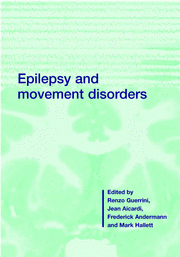Book contents
- Frontmatter
- Contents
- List of contributors
- Preface and overview
- 1 Epilepsies as channelopathies
- 2 Epilepsy and movement disorders in the GABAA receptor β3 subunit knockout mouse: model of Angelman syndrome
- 3 Genetic reflex epilepsy from chicken to man: relations between genetic reflex epilepsy and movement disorders
- 4 Functional MRI of the motor cortex
- 5 Neuromagnetic methods and transcranial magnetic stimulation for testing sensorimotor cortex excitability
- 6 Motor dysfunction resulting from epileptic activity involving the sensorimotor cortex
- 7 Nocturnal frontal lobe epilepsy
- 8 Motor cortex hyperexcitability in dystonia
- 9 The paroxysmal dyskinesias
- 10 Normal startle and startle-induced epileptic seizures
- 11 Hyperekplexia: genetics and culture-bound stimulus-induced disorders
- 12 Myoclonus and epilepsy
- 13 The spectrum of epilepsy and movement disorders in EPC
- 14 Seizures, myoclonus and cerebellar dysfunction in progressive myoclonus epilepsies
- 15 Opercular epilepsies with oromotor dysfunction
- 16 Facial seizures associated with brainstem and cerebellar lesions
- 17 Neonatal movement disorders: epileptic or non-epileptic
- 18 Epileptic and non-epileptic periodic motor phenomena in children with encephalopathy
- 19 Epileptic stereotypies in children
- 20 Non-epileptic paroxysmal eye movements
- 21 Shuddering and benign myoclonus of early infancy
- 22 Epilepsy and cerebral palsy
- 23 Sydenham chorea
- 24 Alternating hemiplegia of childhood
- 25 Motor attacks in Sturge–Weber syndrome
- 26 Syndromes with epilepsy and paroxysmal dyskinesia
- 27 Epilepsy genes: the search grows longer
- 28 Genetics of the overlap between epilepsy and movement disorders
- 29 Seizures and movement disorders precipitated by drugs
- 30 Steroid responsive motor disorders associated with epilepsy
- 31 Drugs for epilepsy and movement disorders
- Index
- Plate section
18 - Epileptic and non-epileptic periodic motor phenomena in children with encephalopathy
Published online by Cambridge University Press: 03 May 2010
- Frontmatter
- Contents
- List of contributors
- Preface and overview
- 1 Epilepsies as channelopathies
- 2 Epilepsy and movement disorders in the GABAA receptor β3 subunit knockout mouse: model of Angelman syndrome
- 3 Genetic reflex epilepsy from chicken to man: relations between genetic reflex epilepsy and movement disorders
- 4 Functional MRI of the motor cortex
- 5 Neuromagnetic methods and transcranial magnetic stimulation for testing sensorimotor cortex excitability
- 6 Motor dysfunction resulting from epileptic activity involving the sensorimotor cortex
- 7 Nocturnal frontal lobe epilepsy
- 8 Motor cortex hyperexcitability in dystonia
- 9 The paroxysmal dyskinesias
- 10 Normal startle and startle-induced epileptic seizures
- 11 Hyperekplexia: genetics and culture-bound stimulus-induced disorders
- 12 Myoclonus and epilepsy
- 13 The spectrum of epilepsy and movement disorders in EPC
- 14 Seizures, myoclonus and cerebellar dysfunction in progressive myoclonus epilepsies
- 15 Opercular epilepsies with oromotor dysfunction
- 16 Facial seizures associated with brainstem and cerebellar lesions
- 17 Neonatal movement disorders: epileptic or non-epileptic
- 18 Epileptic and non-epileptic periodic motor phenomena in children with encephalopathy
- 19 Epileptic stereotypies in children
- 20 Non-epileptic paroxysmal eye movements
- 21 Shuddering and benign myoclonus of early infancy
- 22 Epilepsy and cerebral palsy
- 23 Sydenham chorea
- 24 Alternating hemiplegia of childhood
- 25 Motor attacks in Sturge–Weber syndrome
- 26 Syndromes with epilepsy and paroxysmal dyskinesia
- 27 Epilepsy genes: the search grows longer
- 28 Genetics of the overlap between epilepsy and movement disorders
- 29 Seizures and movement disorders precipitated by drugs
- 30 Steroid responsive motor disorders associated with epilepsy
- 31 Drugs for epilepsy and movement disorders
- Index
- Plate section
Summary
Introduction
Paroxysmal epileptic motor phenomena occurring in the first year of life in symptomatic encephalopathies (hypoxic–ischemic, metabolic or malformative) are frequently constituted by spasms. Apart from the West syndrome, epileptic spasms are characteristic of some specific infantile epileptic syndromes such as Ohtahara syndrome (Ohtahara, 1978), early myoclonic epileptic encephalopathy (Aicardi & Goutires, 1978), tuberous sclerosis complex and Aicardi disease. They may also occur in neurofibromatosis and in other symptomatic encephalopathies of different origin (Commission on Pediatric Epilepsy of the ILAE, 1992; Roger & Dulac, 1994). In these syndromes epileptic spasms tend to recur in clusters. Recently it has been established that epileptic spasms may be present beyond infancy (Gobbi et al., 1987; Commission on Paediatric Epilepsy of the ILAE, 1992; Roger & Dulac, 1994; Talwar et al., 1995). Among these ‘non-age-related’ epileptic spasms, a particular type named periodic spasms has been described and their electroclinical characteristics have been detailed (Gobbi et al., 1987; Bednarek et al., 1998). The term ‘periodic spasms’ has been chosen to emphasize one of the most striking characteristics of these spasms: their repetition into the cluster in an almost periodic sequence at rather regular intervals. The most important aspect of periodic spasms is that the whole cluster of spasms has to be considered as a single, complicated partial seizure, with a particular type of secondary generalization, and not simply as the result of a long-lasting series of seizures (the spasms), which repeat in a periodic sequence (Gobbi et al., 1987). Finally, periodic spasms may be very polymorphous and their clinical expression may be very subtle or suggestive of a movement disorder. As a consequence they may be missed or misdiagnosed.
- Type
- Chapter
- Information
- Epilepsy and Movement Disorders , pp. 307 - 318Publisher: Cambridge University PressPrint publication year: 2001



